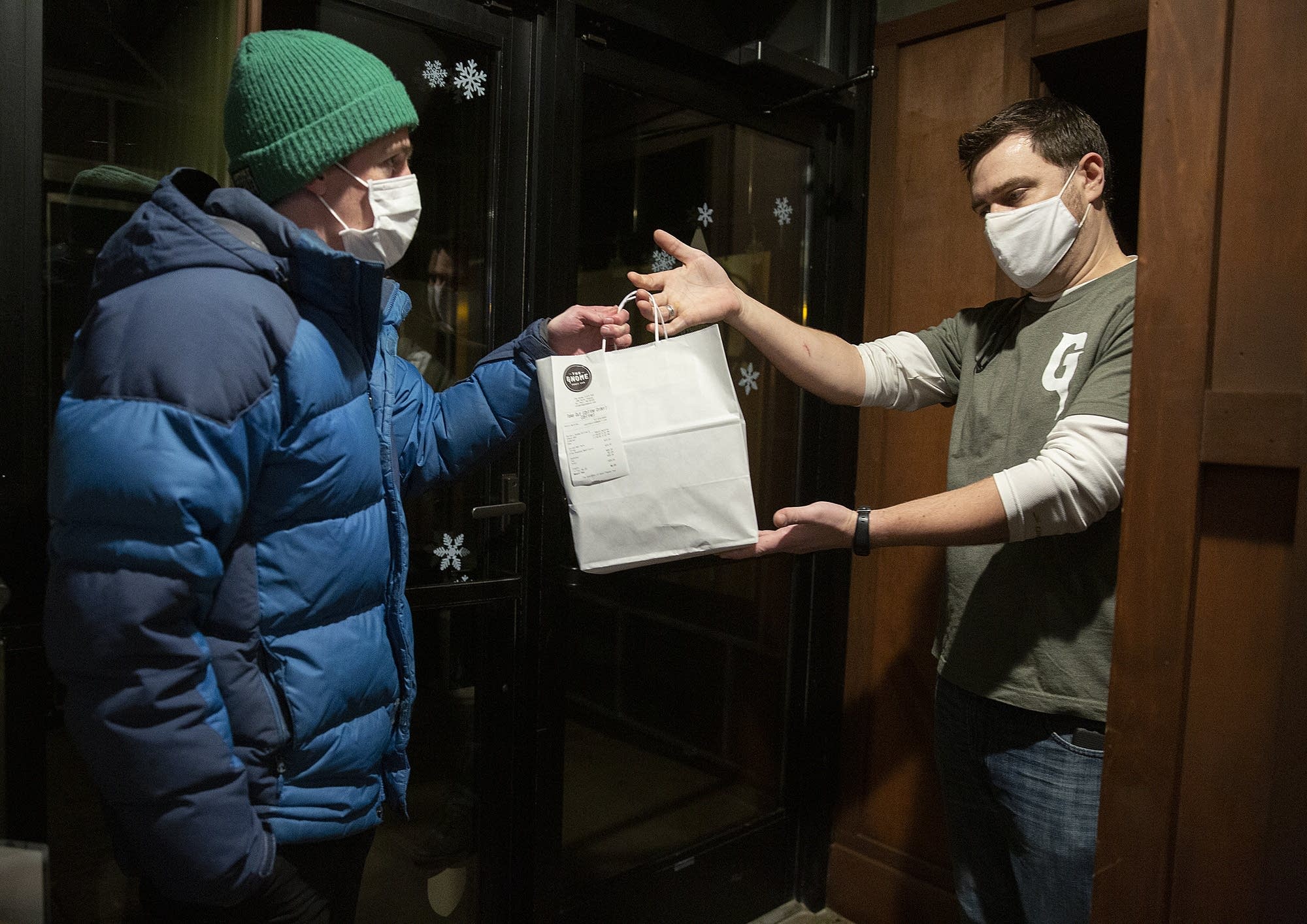Walz extends in-person dining pause through holidays, allow gyms to reopen with restrictions
Published 5:34 am Wednesday, December 16, 2020

- Robin Harkins, left, receives a takeout order from Sean Corrigan, general manager of The Gnome pub in St. Paul on Nov. 18. Christine T. Nguyen/MPR News file
|
Getting your Trinity Audio player ready...
|
Elementary schools OK’d to open conditionally starting Jan. 18
By MPR News staff and Brian Bakst
Gov. Tim Walz on Wednesday said he is extending his current monthlong ban on indoor bar and restaurant service through the year-end holidays as the state works to stem the spread of COVID-19.
The current restrictions limiting bars and restaurants to takeout only were set to expire on Friday. Walz’s revamped order will continue to prohibit indoor service at bars and restaurants.
The new order allows outdoor tables at 50 percent capacity, or 100 people, with four patrons per table. But they can’t be fully enclosed in shelters, making dining or drinking somewhat impractical in Minnesota winter temperatures.
The restrictions will stay in place through Jan. 10, short-circuiting celebrations at bars and restaurants on New Year’s Eve, traditionally a huge night for those businesses.
“We have to beat the virus before the economy comes back,” Walz told reporters after announcing the restrictions and signing legislation that will target $88 million in payments directly to bars and restaurants.
Minnesota continues to deal with high levels of community spread — infections that can’t be traced to a specific source — and the state remains in a “high-risk category” despite recent improvements in COVID-19 metrics, Walz said during an online address.
“There’s a very real chance that there will be another peak coming,” he said, adding later that officials are worried now about a February spike.
The governor is also giving a green light to elementary schools to conditionally open to in-person learning starting Jan. 18.
Those schools “may choose to operate in an in-person learning model as long as they are able to implement additional mitigation strategies, which include providing and requiring staff to wear a face shield and mask and offering regular testing,” according to a statement.
Other changes laid out Wednesday include:
- Gyms and fitness centers. These businesses, which have also been shut for the month, will be allowed to conditionally reopen starting Saturday. They can run at 25 percent capacity with no showers or pool activity allowed, and no group exercise before Jan. 4.
- Youth sports. Teams will be allowed to resume practices on Jan. 4, the people given advance details say, but games won’t be allowed until later.
- Indoor gatherings. The guidance is that Minnesotans may gather inside with one other household up to 10 people.
- Outdoor entertainment venues: They can open at 25 percent capacity, up to 100 people at a time. If food and drink are served, people must be seated.
The governor on Wednesday also signed into law a $216 million economic relief package to aid small businesses and workers damaged by the restrictions to stem the spread of the virus.
The measure, approved in a special session, includes grants to struggling small businesses and an extension of unemployment benefits for out-of-work Minnesotans.
‘Gravely disappointed’
News that the bar and restaurant restrictions will continue is likely to come as a blow to the thousands of bar and restaurant owners and workers across the state.
Those businesses have been forced to do takeout-only or delivery the past few weeks as health officials worked to slow the spread of COVID-19.
Liz Rammer, CEO of the trade group Hospitality Minnesota, said Wednesday morning she was “gravely disappointed” at news of the plan and pleaded with the governor to reconsider.
“Hospitality is a force for good in our communities, and the Governor and his administration would be wise to leverage that force, rather than watch it flicker out,” she said in a statement.
Harsher words came from Tony Chesak, executive director of the Minnesota Licensed Beverage Association. “Today’s news is not only devastating, it’s shameful and unjust,” he said in a statement, adding that less than 2 percent of COVID-19 cases have been tracked back to bars and restaurants.
When the restrictions went into place in November, Minnesota was deep into some of its worst days of COVID-19’s surge across the state since the pandemic began, frequently breaking records on daily case numbers, deaths and hospitalizations.
The virus’ spread put immense pressure on health care workers and hospitals.
In the past few days, though, there’s been positive news on new COVID-19 caseloads and hospitalizations.
Tuesday’s COVID-19 data showed new caseloads and hospitalizations continuing to retreat from their recent highs, with no sign of an expected surge from Thanksgiving holiday celebrations.
Officials say they’ve been working to balance the recent improvement in conditions with the reality that the pandemic isn’t over.
Walz on Wednesday, though, said the recent improvements in conditions haven’t been significant enough for Minnesota to let down its guard.
“We went from really horrendous to just horrendous,” Walz told reporters.
Walz and other officials have expressed hope that the vaccines arriving now in Minnesota and across the country will ease the strain and the need for restrictions eventually, but not yet.
After receiving final federal approvals over the weekend, the Pfizer pharmaceutical company began distribution of its COVID-19 vaccine — the country’s first — with shipments arriving in a handful of Minnesota hospitals and clinics Monday.
Shots began going into arms in Minnesota this week, but officials caution it will take months for vaccinations to be widespread in the state.



